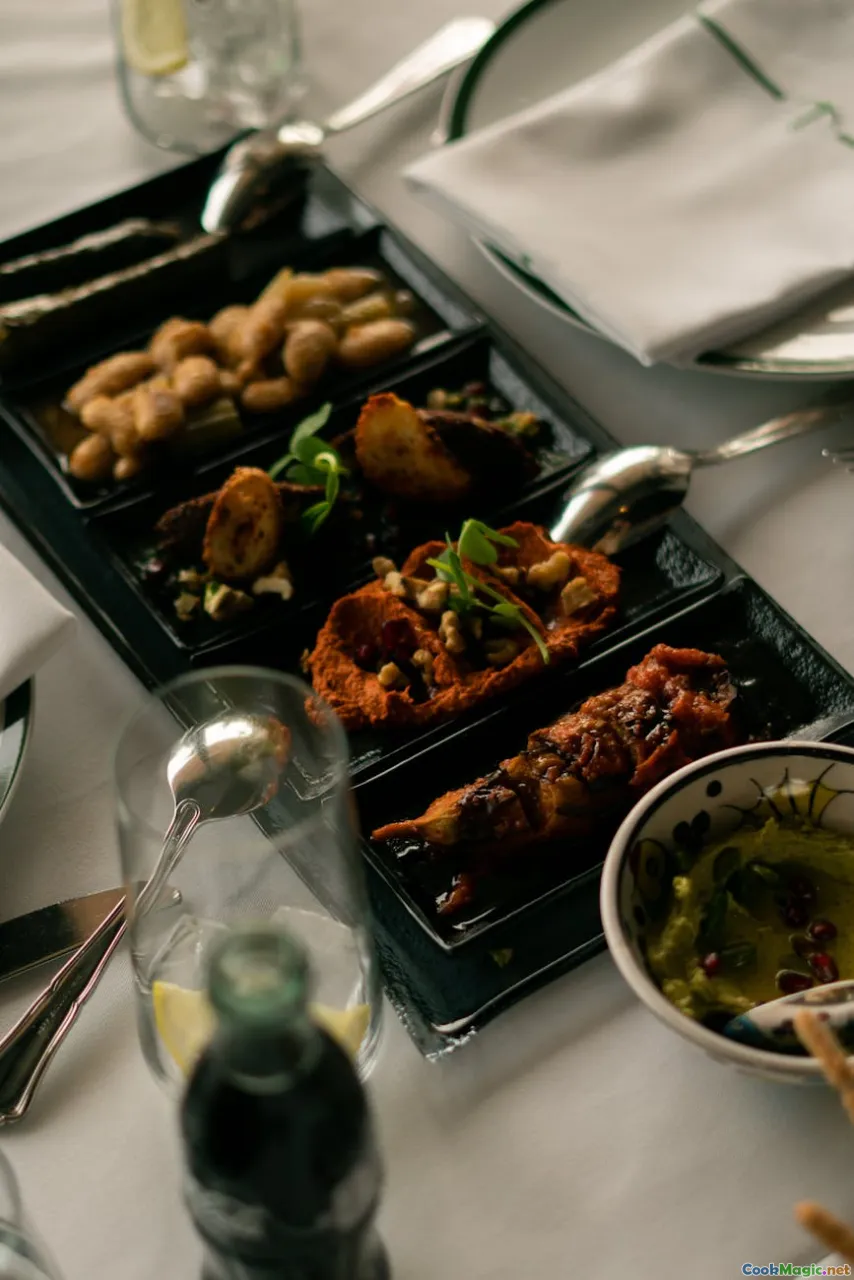The Art of Middle Eastern Mezze
8 min read Discover the vibrant world of Middle Eastern mezze—an artful celebration of shared plates, rich flavors, and cultural storytelling that transforms dining into an experience. April 20, 2025 23:00
The Art of Middle Eastern Mezze
Imagine a table bursting with colors, aromas weaving through the air like a fragrant tapestry, and a symphony of textures—creamy, crunchy, tangy, and smoky—all inviting you into an immersive culinary journey. This is the magic of mezze, a cornerstone of Middle Eastern dining that transforms eating from a mere act of sustenance into a communal celebration.
Introduction: More Than Just Food—A Cultural Experience
In many Middle Eastern cultures, mezze is more than a collection of small dishes; it is a ritual, a social fabric woven through generations. It’s about gathering friends and family around a table, sharing stories and laughter over an array of flavors that reflect the region’s rich history and diverse influences. From the bustling souks of Beirut to the serene cafes of Istanbul, mezze embodies the spirit of hospitality and conviviality.
Historical Roots of Mezze
Tracing the origins of mezze reveals a fascinating tapestry of history and cultural exchange. The practice likely dates back thousands of years, with influences from Persian, Ottoman, Arab, and Mediterranean cuisines blending seamlessly.
In ancient Persia, small dishes known as mazzeh were served alongside wine and bread, fostering social bonding. The Ottoman Empire further popularized mezze as an integral part of palace cuisine, elevating it to an art form with intricate presentation and a variety of flavors.
Throughout centuries, mezze has been a symbol of hospitality—an invitation to share, to connect, and to savor life’s simple pleasures. Today, it remains an enduring emblem of Middle Eastern identity.
The Components of a Mezze Platter
A traditional mezze spread is a harmonious medley of cold and hot dishes, each crafted to complement the others. Let’s explore some of the most beloved elements:
Hummus and Baba Ganoush
Creamy, luscious, and deeply flavorful, hummus—a blend of chickpeas, tahini, lemon juice, and garlic—is a staple that offers comforting familiarity. Baba ganoush, smoky roasted eggplant pureed with tahini and olive oil, provides an earthy counterpoint. Both are served with warm, fluffy pita bread that’s perfect for scooping.
Fresh Vegetables and Pickles
Crisp cucumbers, radishes, cherry tomatoes, and tangy pickles add brightness and crunch, balancing richer dishes. Pickled vegetables, such as turnips and peppers, bring a sharp acidity that cuts through creamy textures.
Kebabs and Grilled Meats
Tender cubes of marinated lamb, chicken, or beef skewered and grilled to perfection introduce smoky richness. Their savory aroma entices diners and invites a sense of communal sharing.
Labneh and Cheeses
Thick, tangy strained yogurt—labneh—is often drizzled with olive oil and sprinkled with za’atar or sumac. Soft cheeses like feta or halloumi add saltiness and depth.
Salads and Grain Dishes
Tabbouleh, with its fresh parsley, bulgur, and lemon, offers a herby, zesty bite. Mujaddara—a hearty lentil and rice dish—embodies comfort and sustenance.
Sweets and Pastries
No mezze is complete without a touch of sweetness—dates, baklava, or ma’amoul filled with nuts provide a delightful end to the feast.
The Art of Presentation and Sharing
Presentation is as vital as flavor in mezze. Dishes are arranged in vibrant, inviting displays—think colorful ceramic platters, ornate bowls, and wooden trays—that encourage guests to serve themselves freely.
Sharing is at the heart of mezze. Whether in a bustling Beirut café or a quiet family home, the act of passing dishes around fosters bonds and creates a sense of community. This shared experience turns eating into a social ritual—an expression of generosity and friendship.
Cooking Techniques and Flavors
Mastering mezze involves a balance of techniques—grilling, marinating, fermenting, and blending—all aimed at enhancing natural flavors.
- Grilling: Imparts smoky depth, especially in kebabs and vegetables.
- Marinating: Tenderizes meat and infuses it with herbs, spices, and citrus.
- Fermentation: Creates tangy pickles and preserves, adding complexity.
- Blending: Smooth hummus and dips require precise emulsification for silky textures.
Bold spices such as sumac, za’atar, cumin, and cinnamon are often used to elevate dishes, while fresh herbs like parsley, mint, and cilantro add vibrancy.
Personal Reflections and Cultural Significance
Having traveled extensively through the Levant and North Africa, I’ve witnessed firsthand how mezze is more than just food—it's a way of life. In a small village in Lebanon, I watched an elderly woman prepare her homemade labneh and serve it with freshly baked flatbread, her eyes twinkling with pride. In Istanbul, I joined locals in a bustling meyhane, where plates of grilled fish, salads, and mezes flowed effortlessly, accompanied by lively conversation.
These experiences underscore the emotional resonance of mezze; it’s about connection, tradition, and the joy of sharing flavors that have been cherished for centuries.
Modern Interpretations and Fusion
Contemporary chefs are reimagining mezze with innovative twists—vegan options, gluten-free dips, and fusion flavors that incorporate global ingredients. Yet, at its core, the essence remains rooted in hospitality and community.
For instance, a modern mezze platter might feature roasted beet hummus, avocado baba ganoush, and quinoa tabbouleh—creating a vibrant, healthful, and inclusive dining experience.
Final Thoughts: Embracing the Mezze Spirit
Embracing mezze means embracing a philosophy of sharing, of savoring life's flavors together. It’s an artful dance of tradition and innovation, of taste and storytelling. Whether you’re hosting a dinner party or enjoying a quiet meal, let the mezze tradition inspire you to create moments of connection and joy.
So next time you gather around a table, think beyond the main course—think of the mezze, a celebration of the rich tapestry of Middle Eastern cuisine that invites us all to partake in its timeless, flavorful story.









